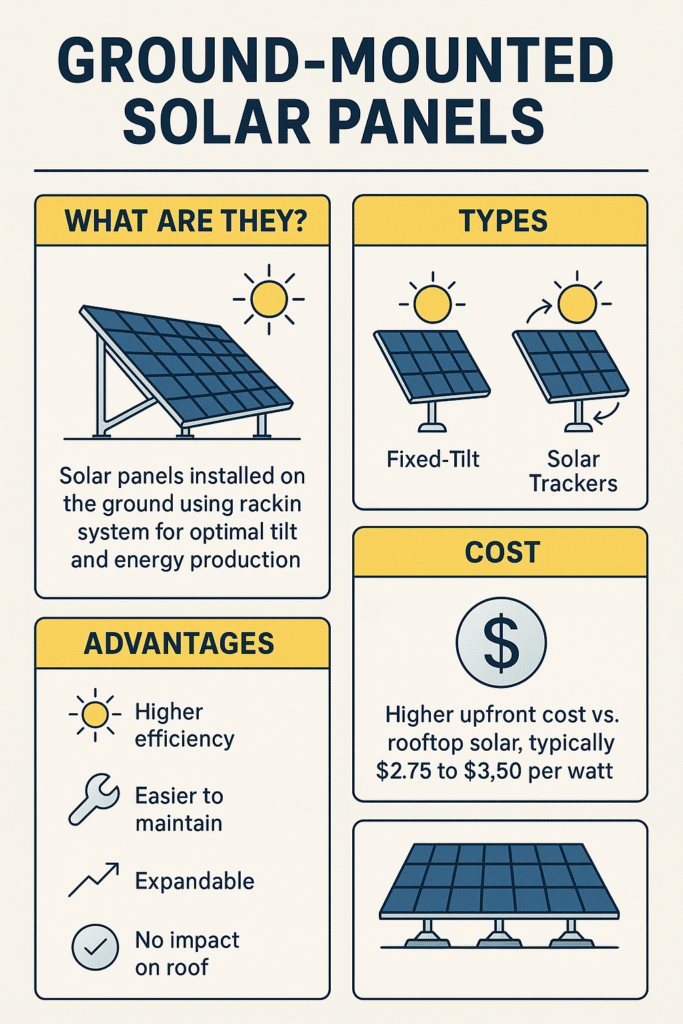As solar energy becomes increasingly mainstream, many homeowners are discovering that rooftop solar isn’t the only game in town. Ground-mounted solar panels offer a powerful alternative that can deliver higher energy yields, easier maintenance, and long-term flexibility.
Whether you’re on a spacious suburban property, a rural estate, or simply have an underutilized backyard, ground-mounted systems might be your golden ticket to energy independence. In this guide, we’ll explore everything homeowners need to know in 2025, from system types and installation to costs, benefits, and long-term value.
What Are Ground-Mounted Solar Panels?

Ground-mounted solar panels are photovoltaic systems installed directly on the ground rather than on rooftops. These systems are supported by metal frames or pole structures anchored into the earth, allowing for customizable tilt and orientation.
Unlike rooftop systems, which are constrained by roof angle, shape, and shading, ground-mounted systems can be optimized for maximum sun exposure throughout the year. This translates to potentially higher electricity production over time.
There are two major types:
- Fixed-tilt ground mounts that remain in one position.
- Tracking systems that follow the sun for greater efficiency.
Ground-Mounted vs Rooftop Solar Panels
Choosing between rooftop and ground-mounted solar involves more than just available space. Here’s a detailed comparison that highlights key differences:
| Feature | Ground-Mounted Solar | Rooftop Solar |
|---|---|---|
| Installation Location | Open land, backyard, or unused property space | Existing roof structure |
| Energy Efficiency | Higher due to optimal tilt and airflow | Lower due to roof angle and obstructions |
| Installation Complexity | More groundwork and site preparation | Simpler if roof is suitable |
| Maintenance Access | Easy to clean and inspect | Harder to reach and clean |
| System Expandability | Easily expandable | Limited by roof size |
| Permitting Requirements | May involve zoning approval or land-use rules | Typically simpler in residential zones |
| Aesthetic Considerations | Visible from ground level | Less visible if flush-mounted |
| Long-Term Roof Impact | None | Roof penetrations may affect warranty |
Types of Ground-Mounted Solar Systems
Ground-mounted systems come in multiple configurations, each with its own pros, costs, and ideal use cases.
Fixed-Tilt Ground Mounts
- These are the most common and cost-effective systems.
- Panels are set at a fixed angle, optimized for your geographic latitude.
- Ideal for homeowners who want a reliable, low-maintenance setup.
Single-Axis Solar Trackers
- These rotate on one axis, usually east to west, following the sun’s daily path.
- They increase energy output by approximately 15 to 25 percent.
- Better suited for homeowners with high electricity needs or who want maximum ROI.
Dual-Axis Solar Trackers
- These follow the sun both daily and seasonally, adjusting in both azimuth and elevation.
- They can boost energy production by up to 40 percent.
- More complex and expensive, but excellent for maximizing land efficiency.
Comparison Table
| System Type | Motion | Efficiency Gain | Cost Range (Per Watt) | Best For |
|---|---|---|---|---|
| Fixed-Tilt | None | Baseline | $2.75 – $3.25 | Budget-conscious homeowners |
| Single-Axis Tracker | East–West | +15% to +25% | $3.00 – $3.75 | Higher usage homes |
| Dual-Axis Tracker | All directions | +30% to +40% | $3.75 – $4.50+ | Tech-savvy homeowners with space |
How Are Ground-Mounted Solar Panels Installed?

The installation process for ground-mounted systems is thorough and includes several specialized steps:
- Site Assessment and Shading Analysis
- Solar professionals analyze your land for slope, orientation, and obstructions.
- Advanced software tools (like PVsyst or Helioscope) simulate energy yield.
- Soil Testing and Engineering
- Ground conditions affect racking structure choice.
- Rocky or sandy soils may require alternative mounting techniques like helical piles.
- Racking Installation
- Frames are anchored into the ground using driven piles or cement footings.
- Systems are spaced to avoid panel shading and allow airflow.
- Panel and Electrical Installation
- Panels are mounted to racks and wired to inverters.
- Trenching is done for underground cabling to connect to your main service panel.
- Inspection and Grid Connection
- City inspectors and utility companies approve the system before activation.
How Much Do Ground-Mounted Solar Panels Cost in 2025?
While ground-mounted systems typically cost more than rooftop setups, they also provide higher energy output and easier maintenance.
| Cost Factor | Average Range in 2025 |
|---|---|
| Total Installed Cost per Watt | $2.75 to $3.75 |
| 6 kW System Estimate | $16,500 to $22,500 |
| Additional Site Work (grading) | $1,000 to $5,000+ |
| Single-Axis Tracking Upgrade | +$2,000 to $4,000 |
Key Cost Variables
- Trenching distance from panels to home
- Type of racking or tracking system
- Local labor rates
- Permits and engineering fees
- Soil type and land grading needs
Despite the upfront cost, many systems pay for themselves in 6 to 10 years through utility bill savings and incentives.
Incentives for Ground-Mounted Solar in 2025
Homeowners can take advantage of several programs to reduce out-of-pocket costs:
Federal Incentive
- Investment Tax Credit (ITC): 30 percent off total system cost for installations through 2032
State and Local Rebates
- California, Texas, and several other states offer property tax exemptions and rebates
- Utility companies often have solar performance-based incentives (PBIs)
Agricultural Incentives
- USDA’s REAP Program offers grants up to 50 percent of eligible costs for rural homeowners or farm operations
Net Metering
- Still widely available in most states
- Allows homeowners to earn bill credits for excess power sent to the grid
Advantages of Ground-Mounted Solar for Homeowners
- Better Efficiency
- Custom tilt and orientation = higher output per panel
- Easier Maintenance
- Clean panels after dust, snow, or leaves without ladders
- Expandable
- Add panels later without structural limits
- No Roof Interference
- No penetrations, no impact on warranties
- Improved Cooling
- Airflow beneath panels keeps temperatures down and efficiency up
- Agrivoltaics Potential
- Allows dual use of land for gardening or grazing
Challenges to Consider
- Land Requirement
- Not ideal for small lots or urban areas
- Visual Footprint
- It may be more noticeable in the yard
- Higher Upfront Costs
- Especially with tracking systems
- Zoning and Permitting
- Some HOAs or counties may restrict ground-mounted systems
Is Ground-Mounted Solar Right for You?
This system is ideal if you:
- Own at least one-fourth acre or more of unshaded land
- Want to avoid roof penetrations
- Are you planning to expand your solar system over time
- Live in rural or semi-rural areas
- Have high energy consumption and want maximum output
Frequently Asked Questions
Can I install ground-mounted solar in my backyard?
Yes, as long as you have sufficient space and no zoning restrictions.
Is ground-mounted solar safe for children or pets?
Proper fencing and placement ensure full safety, even in family environments.
What maintenance is required?
Routine cleaning, wire inspection, and vegetation management once or twice a year.
Can I grow crops under solar panels?
Yes, this is called agrivoltaics, and it’s gaining momentum in 2025.
How long do these systems last?
Panels typically last 25 to 30 years. Racking and mounts often last even longer.
Final Thoughts
Ground-mounted solar panels are one of the most flexible and powerful renewable energy options for homeowners in 2025. While they may require more land and upfront investment, their long-term payoff, ease of maintenance, and expansion potential make them a smart choice—especially for those who want full control over their energy setup.
If you’re serious about maximizing your solar potential, reach out to NRG Clean Power for a free site analysis. Our team specializes in designing high-performance systems that match your goals, land, and lifestyle.

